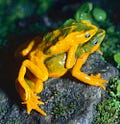By Jordan Schaul | National Geographic | August 19, 2013
The St. Louis Zoo’s WildCare Institute is drawing attention to an endangered group of frogs. Also known as stubfoot toads, harlequin toads represent a beautiful, but vanishing frog taxon from Central and South America.
The Zoo has partnered with Ecuador’s Jambatu Center for Research and Conservation of Amphibians to help conserve some of South America’s most imperiled amphibians, including the harlequin toads.
According to a St. Louis Zoo spokesperson, “Most of the harlequin frog species are listed as critically endangered and endangered with a very high risk of extinction—a problem faced by as much as half of the planet’s more than 6,000 amphibian species.”
Recently, the two collaborating zoological organizations were awarded nearly $25,000 dollars from the USFWS to build a breeding and captive management facility dedicated to harlequin toad conservation on the Jambatu Center’s Ecuadorian campus.
Westerners often think of the bufonids, the true toads (Family: Bufonidae) as robust and drab-colored terrestrial frogs. Among the cosmopolitan genus Bufo, which comprises 150 species—many are, indeed, robust and drab-colored. In fact, with the exception of professional herpetologists and other herpetophiles, Bufo species don’t typically draw “oohs” and “aahs” from anyone. Harlequin toads from the genus Atelopus, do, however. This vibrantly colored group of bufonids is particularly attractive.
Unfortunately, harlequin toads are disappearing right in front of our eyes.
The Zoo spokesperson said, “The grant will go toward building an additional frog building with frog rooms, feeder insect room, and meeting/office space to help save eight species of harlequin frog from extinction through breeding and management.”
“Ecuador is lucky to have one of the world’s finest amphibian biologists, Dr. Luis Coloma, as a resident. With the world’s amphibian populations in drastic decline, the Saint Louis Zoo’s WildCare Institute made a decision to support Dr. Coloma and his ongoing program dedicated to the conservation and sustainability of Ecuadorian amphibians,” says Mark Wanner, Saint Louis Zoo Zoological Manager of Herpetology & Aquatics.”
“Centro Jambatu is a great example of scientific research, captive breeding, and strong collaborative effort to ensure species survival,” he adds. “Due to the factors affecting wild amphibian populations today these assurance colonies become the last hope for many unique amphibian species.”
The harlequin toad, like many other neotropical amphibians, is at risk namely because of a fungal disease, which also plagues amphibian populations worldwide.
ABOUT NATIONAL GEOGRAPHIC SOCIETY
The National Geographic Society is a global nonprofit organization that uses the power of science, exploration, education and storytelling to illuminate and protect the wonder of our world. Since 1888, National Geographic has pushed the boundaries of exploration, investing in bold people and transformative ideas, providing more than 14,000 grants for work across all seven continents, reaching 3 million students each year through education offerings, and engaging audiences around the globe through signature experiences, stories and content. To learn more, visit www.nationalgeographic.org or follow us on Instagram, Twitter and Facebook.
MEET THE AUTHOR
Jordan Carlton SchaulWith training in wildlife ecology, conservation medicine, and comparative psychology, Dr. Schaul's contributions to Nat Geo Voices have covered a range of environmental and social topics. He draws particular attention to the plight of imperiled species highlighting issues at the juncture or nexus of sorta situ wildlife conservation and applied animal welfare. Sorta situ conservation practices are comprised of scientific management and stewardship of animal populations ex situ (in captivity / 'in human care') and in situ (free-ranging / 'in nature'). He also has a background in behavior management and training of companion animals and captive wildlife and conservation marketing and digital publicity. Jordan has shared interviews with colleagues and public figures, as well as editorial news content. In addition, he has posted narratives describing his own work, which include the following examples: • Restoration of wood bison to the Interior of Alaska (As Animal Curator at Alaska Wildlife Conservation Center and courtesy professor at the University of Alaska) • Rehabilitation of orphaned sloth bears exploited for tourists in South Asia (As executive consultant 'in-residence' at the Agra Bear Rescue Center managed by Wildlife SOS) • Censusing small wild cat (e.g. ocelot and margay) populations in the montane cloud forests of Costa Rica for popular publications with 'The Cat Whisperer' Mieshelle Nagelschneider • Evaluating the impact of ecotourism on marine mammal population stability and welfare off the coast of Mexico's Sea of Cortez (With Boston University's marine science program) Jordan was a director on boards of non-profit wildlife conservation organizations serving nations in Africa, North and South America and Southeast Asia. He is also a consultant to a human-wildlife conflict mitigation organization in the Pacific Northwest. Following animal curatorships in Alaska and California, he served as a charter board member of a zoo advocacy and outreach organization and later as its executive director. Jordan was a member of the Communication and Education Commission of the International Union for the Conservation of Nature (CEC-IUCN) and the Bear Specialist Group of the IUCN Species Survival Commission (BSG-SSC-IUCN). He has served on the advisory council of the National Wildlife Humane Society and in service to the Bear Taxon Advisory Group of the Association of Zoos and Aquariums (AZA Bear TAG). In addition, he was an ex officio member of the council of the International Association for Bear Research and Management.



